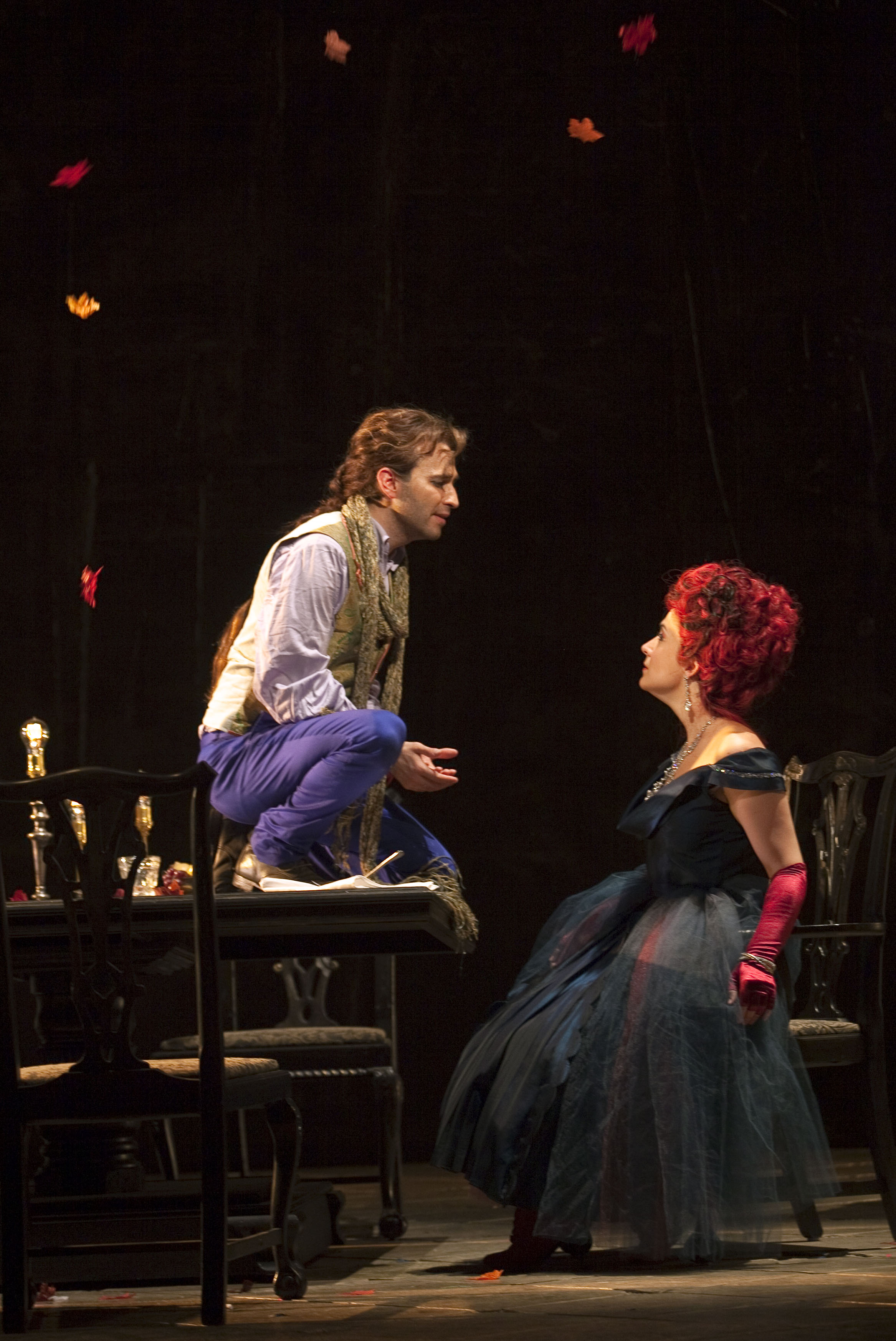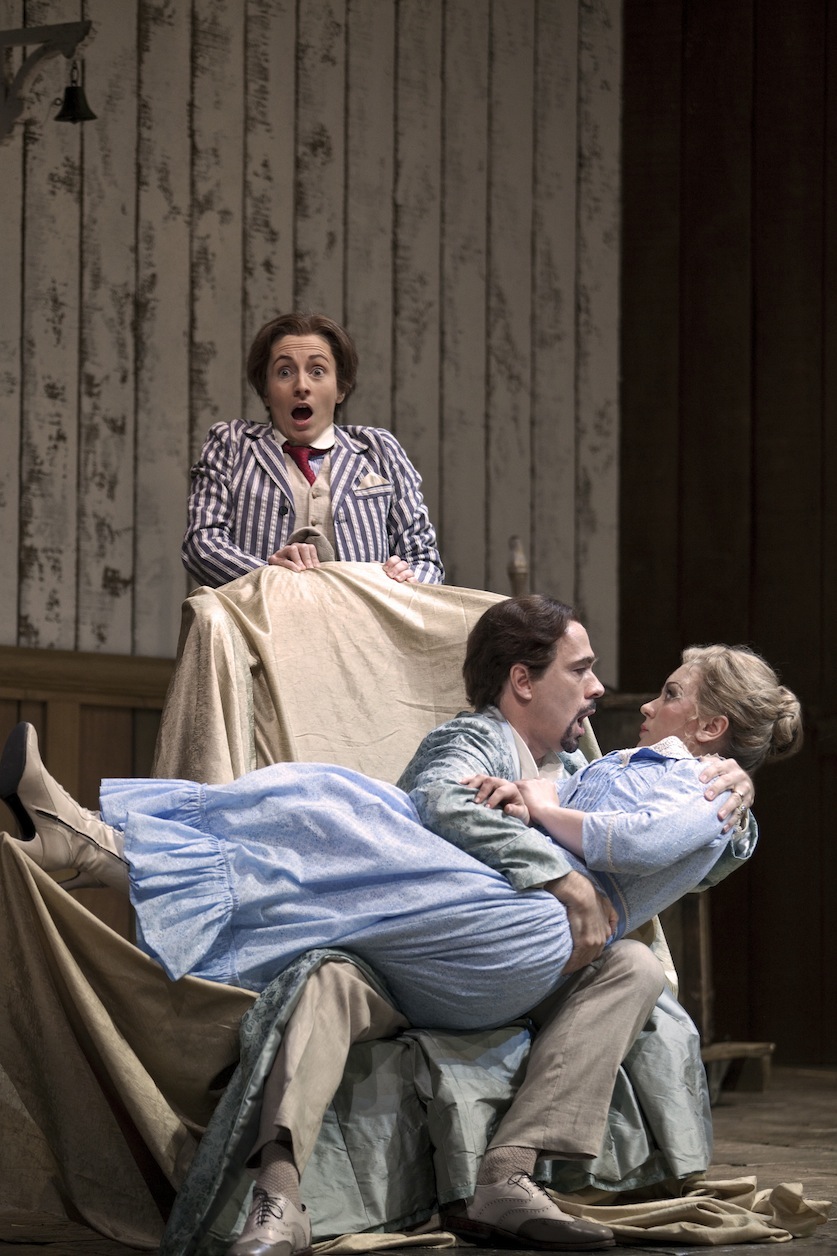Directorial excess sabotages “Tolomeo” premiere at Glimmerglass while “Figaro” fares better

Anthony Roth Costanzo as Tolomeo and Julie Boulianne as Elisa in Glimmerglass Opera's "Tolomeo." Photo: Karli Cadel/Glimmerglass Opera.
Michael MacLeod’s five-year term as general and artistic director of Glimmerglass Opera is drawing to close. In February it was announced that he would leave the company at the end of the 2010 season. Then, less than a month later, the company announced that Francesca Zambello would be MacLeod’s successor, leaving the distinct impression that her appointment was in place the whole time. The Glimmerglass board must have wanted a leader with a higher profile than MacLeod’s, and this it has found in the experienced and respected director, who will bring a wealth of contacts to Cooperstown as well as her own proven artistic ability.
As for MacLeod, he kept Glimmerglass humming along nicely. He will be remembered primarily for two innovative and artistically successful thematic seasons, one consisting of Orpheus operas, the other loosely based on Shakespeare. Last summer saw retrenchment, as if when planning it MacLeod and/or other powers at Glimmerglass had advance word of the impending financial crisis (the 2009 season was announced in May 2008.).
But Glimmerglass has bounded back, once again offering four full productions, two of which involve rarities. It is a season worthy of MacLeod’s predecessor, Paul Kellogg, but it also points up areas that Zambello needs to address. One is Glimmerglass’s occasional tendency to purvey “opera lite,” especially when presenting Handel.
Of course, one should be grateful for all the Handel operas done at Glimmerglass over the years, but when a production sinks to the level of Chas Rader-Shieber’s treatment of Tolomeo, I’m not so sure. Rader-Shieber’s 2003 production of Orlando had its childish moments. But for the first-ever professional production of Tolomeo in the United States, he turns to all-out farce.
Clearly, the opera is not one of Handel’s strongest dramatically, but it is assuredly not a comedy. The plot involves a devoted couple from Egypt, Tolomeo, the rightful king, and his wife Seleuce. He has been deposed, she is believed a victim of a shipwreck, but both turn up in Cyprus, where, unbeknownst to the other, each assumes the guise of a shepherd. They immediately attract the amorous attentions of the Cypriot king Araspe, who falls in love with Seleuce, and of Araspe’s sister Elisa, who falls in love with Tolomeo. Araspe and Elisa are the piece’s villains, determined to thwart a reuniting of Tolomeo and Seleuce, even with threats of death.
Rader-Shieber takes none of this seriously, but Handel’s music tells us otherwise. His last opera for the Royal Academy of Music, Tolomeo premiered with a great cast: the castrato Senesino was Tolomeo and the rival prima donnas Francesca Cuzzoni and Faustina Bordoni sang Seleuce and Elisa. Marital devotion is the main theme of the opera, but fraternal loyalty is also dealt with, as Alessandro (Tolomeo’s rival for the Egyptian throne) ultimately sides with his brother in Tolomeo’s struggle against Araspe.
At Tuesday night’s premiere, the laughs began at once. In lieu of the seashore, the opera opens indoors, with Tolomeo lamenting his fate—loss of both the throne and Seleuce—while gazing on a goldfish bowl. The shipwrecked Alessandro enters carrying scale models of ships. Araspe and Elisa look ridiculous in Andrea Hood’s costumes. But Rader-Shieber sees to it that the noble couple is mocked too. When Seleuce invokes the breezes to waft her feelings of heartache to her husband, she turns on several electric fans. In her final duet with Tolomeo after matters have been reconciled—one of Handel’s most heartwarming duets—they start taking off their clothes. The romp continues as Alessandro and Elisa (gratuitously paired off) do the same, and so too does Araspe, even though he has no partner. Rader-Shieber does nothing for Tolomeo except make it the butt of his crude jokes.
Given the context, it is no surprise that none of the singers makes much of an impression. Anthony Roth Costanzo has been touted as a young countertenor to keep an eye on. He sings with a pleasant voice of average (for a countertenor) weight but his Tolomeo is nothing memorable. Julie Boulianne’s resonant soprano demonstrates a capacity for brilliance in Elisa’s music, while Joélle Harvey’s more lyrical soprano, despite occasional harshness, serves Seleuce well. Steven LaBrie and Karin Mushegain perform gamely as Araspe and Alessandro. The conductor Christian Curnyn draws stylish playing from the orchestra but he has an archlute strum along in several of the quicker arias where the usual combination of harpsichord and theorbo would serve Handel better. Three arias are omitted and three others are performed A-section only. The three-act opera is given with a single intermission in the middle of Act 2, a lamentable practice that undermines Handel’s musical architecture. But that is the least of the problems with this Tolomeo.

Aurhelia Varak as Cherubino, Mark Schnaible as the Count and Lyubov Petrova as Susanna in Glimmerglass Opera's "Le nozze di Figaro." Photo: Karli Cadel/Glimmerglass Opera.
Mozart’s Le nozze di Figaro went much more smoothly Monday night in an agreeable staging by the experienced director Leon Major. Major says nothing really new about Figaro, but in light of the Tolomeo production that hardly seemed a drawback. For some reason Major gave special prominence to Don Basilio and even to the nonentity Don Curzio, the notary, who actually appeared and sang in the Act 2 finale, presumably doubling Basilio’s music. (For what it’s worth, these two characters were sung by the same singer at the opera’s 1786 premiere.) Basilio turned up unexpectedly a couple of times, thereby reinforcing his reputation as a busybody, which in any case is amply spelled out by Mozart and librettist Da Ponte. If Major really thought Basilio deserved more attention, he should have let Alex Mansoori, an able tenor, sing the music master’s traditionally cut Act 4 aria.
This season at Glimmerglass the sets for all four operas are by Donald Eastman and derive from an earlier production of Britten’s Death in Venice. Basically they involve two large panels on either side of the stage that slant toward the back, with a space between them. But the sets prove to be quite versatile and in Figaro aptly suggest the richly appointed Almaviva estate. For the garden setting of Act 4 a broken-down wagon supplies hiding places for the characters’ nocturnal intrigues.
Lyubov Petrova’s vivacious Susanna is pure delight, sung with a voice of glowing resonance that could hardly be bettered in the role. Caitlin Lynch’s luminous soprano and delicately etched phrasing make a mark in the Countess’s music, but she over-ornaments the reprise of Dove sono and the aria is unwisely repositioned. (Its poignancy comes through so much more effectively when, in accordance with Mozart’s ordering, it follows the jubilant sextet.) Aurhelia Varak looks great as a Cherubino nattily dressed in striped blazer and two-tone shoes (costumes by Matthew Pachtman) and sings well too, despite moments of unsteadiness. Patrick Carfizzi is a sprightly Figaro and Mark Schnaible a strong Count, but his aria, which he sang sitting down, needs more of a hot-tempered edge. Glimmerglass’s music director, conductor David Angus, keeps the spirits high.
Tolomeo runs through August 23, and Le nozze di Figaro through August 22. 607-547-2255; www.glimmerglass.org.